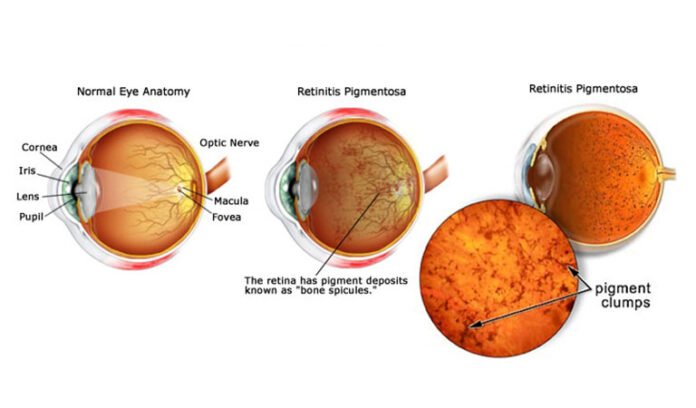Retinitis pigmentosa (RP) is a group of inherited disorders that cause progressive peripheral vision loss and night vision difficulties, eventually leading to central vision loss. This degenerative disease affects the retina, the light-sensitive tissue at the back of the eye. RP typically manifests in childhood or adolescence but can progress at varying rates, potentially leading to significant vision impairment by adulthood.
Symptoms
The symptoms of retinitis pigmentosa vary depending on the specific genetic mutation and can progress over time. Common symptoms include:
- Night blindness: Difficulty seeing in low light conditions, often one of the earliest signs.
- Peripheral vision loss: Gradual narrowing of the field of vision, leading to “tunnel vision.”
- Central vision loss: As the disease progresses, central vision can also deteriorate, making tasks like reading and recognizing faces difficult.
- Color vision deficiency: Some individuals may experience difficulties distinguishing colors.
- Light sensitivity: Increased sensitivity to bright lights and glare.
- Vision fluctuations: Vision may fluctuate, with periods of relative stability followed by periods of rapid decline.
Causes
Retinitis pigmentosa is primarily caused by genetic mutations. These mutations can be inherited in several ways:
- Autosomal recessive: Both parents carry one copy of the mutated gene but typically do not exhibit symptoms. The risk for each child to inherit the disorder is 25%.
- Autosomal dominant: One parent carries the mutated gene and is usually affected by the disorder. Each child has a 50% chance of inheriting the condition.
- X-linked: The mutated gene is located on the X chromosome. Males are more severely affected, while females are often carriers with milder symptoms.
Over 100 genes have been associated with RP, and the specific mutation can influence the severity and progression of the disease.
Treatment
Currently, there is no cure for retinitis pigmentosa, but several treatments can help manage symptoms and slow disease progression:
- Vitamin A: High doses of vitamin A palmitate have been shown to slow the progression of RP in some individuals. However, this treatment requires careful monitoring due to potential toxicity.
- Omega-3 fatty acids: Some studies suggest that a diet rich in omega-3 fatty acids may be beneficial.
- Retinal implants: Devices such as the Argus II Retinal Prosthesis System can provide some visual function to individuals with severe RP.
- Gene therapy: Experimental treatments are exploring the potential of gene therapy to correct specific genetic mutations.
- Stem cell therapy: Research is ongoing into the use of stem cells to replace damaged retinal cells.
- Low vision aids: Devices such as magnifiers, night vision scopes, and specialized glasses can help maximize remaining vision.
- Mobility training: Orientation and mobility training can help individuals navigate their environments more safely.
Prevention
Since retinitis pigmentosa is a genetic disorder, prevention strategies focus on genetic counseling and early diagnosis:
- Genetic counseling: Individuals with a family history of RP may benefit from genetic counseling to understand their risk of passing the disorder to their children.
- Genetic testing: Identifying specific genetic mutations can help predict disease progression and inform family planning decisions.
- Regular eye exams: Early detection through regular eye examinations can help manage symptoms and slow disease progression.
Research into treatments and potential cures for retinitis pigmentosa is ongoing, offering hope for more effective therapies in the future.
































